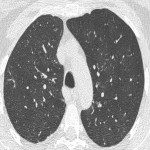Learning objectives
Air trapping is a common finding when reviewing CT scans of the thorax, and is widely accepted as an indirect sign of small airways disease. In this pictorial essay, we describe the approach to assessing air trapping on CT and describe the aetiologies where imaging plays a pivotal role in diagnosis.
Background
Air trapping is abnormal retention of air distal to a complete or partial airway obstruction. Radiologically, this appears as areas of lung parenchyma that fail to increase in attenuation and/or reduce in volume normally on expiration. This results in geographic areas of differing (mosaic) attenuation. 1
Average attenuation of the lung parenchyma increases by 150 HU between inspiratory and expiratory phases, 2 with a change of less than 70 HU regarded as abnormal. 1 The affected lung also maintains most of its volume on expiration....
Imaging findings OR Procedure details
The most common causes of air trapping are asthma and bronchiolitis, usually diagnosed clinically and with PFTs. Other causes include respiratory bronchiolitis-interstitial lung disease (RB-ILD), sarcoidosis, bronchiolitis obliterans (BO) and hypersensitivity pneumonitis (HP). 12 Rarer conditions include vasculitides and diffuse idiopathic pulmonary neuroendocrine cell hyperplasia (DIPNECH). 13 In this pictorial essay, we illustrate the diseases that require CT imaging for diagnosis, including BO, HP, DIPNECH, RB-ILD and sarcoidosis.
Bronchiolitis obliterans
BO is a rare subset of bronchiolitis commonly affecting women between 40 and 60 years...
Conclusion
Various small airways diseases result in air trapping on CT imaging. Most common causes are COPD and asthma, usually diagnosed on clinical assessment and PFTs. More uncommon diseases in which CT plays a pivotal role in the diagnosis include RB-ILD, sarcoidosis, bronchiolitis obliterans, hypersensitivity pneumonitis, and DIPNECH. A technically adequate expiratory CT study is vital to identify air trapping. The radiologist should be aware of the potential pitfalls of apparent air trapping in normal individuals.
Personal information
S. Tan:
Nothing to disclose
B. Saffar:
Nothing to disclose
S. Melsom:
Nothing to disclose
J. Wrobel:
Nothing to disclose
A. Laycock:
Nothing to disclose
References
1. Webb W, Müller N, Naidich D. High-resolution CT of the lung. 2014.
2. Mohamed Hoesein F, de Jong P. Air trapping on computed tomography: regional versus diffuse. European Respiratory Journal. 2017;49(1):1601791.
3. Ranu H, Wilde M, Madden B. Pulmonary function tests. Ulster Med J. 2011 May;80(2):84-90. PMID: 22347750; PMCID: PMC3229853.
4. Hopkins E, Sharma S. Physiology, functional residual capacity. Treasure Island (FL): StatPearls Publishing; 2020.5. Mastora I, Remy-Jardin M, Sobaszek A, Boulenguez C, Remy J, Edme J. Thin-Section CT Finding in 250 Volunteers: Assessment...




















